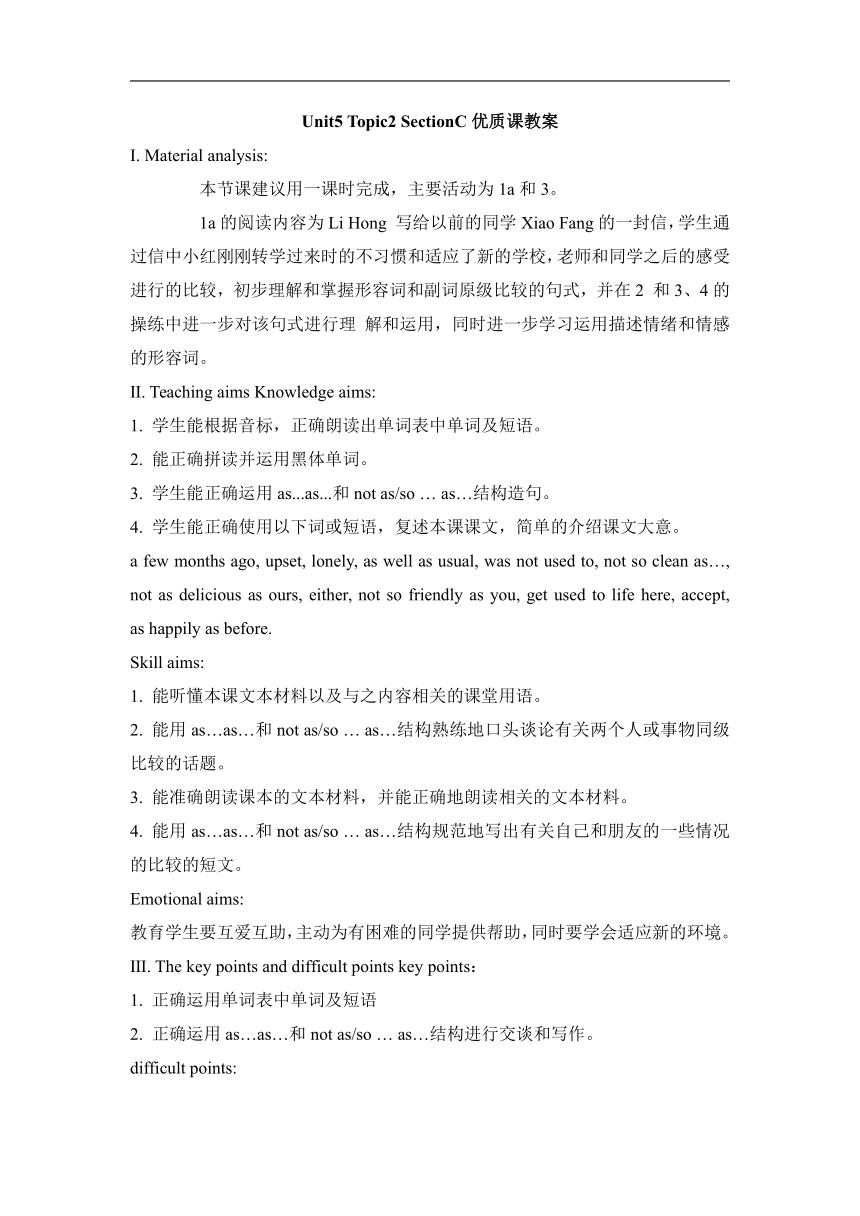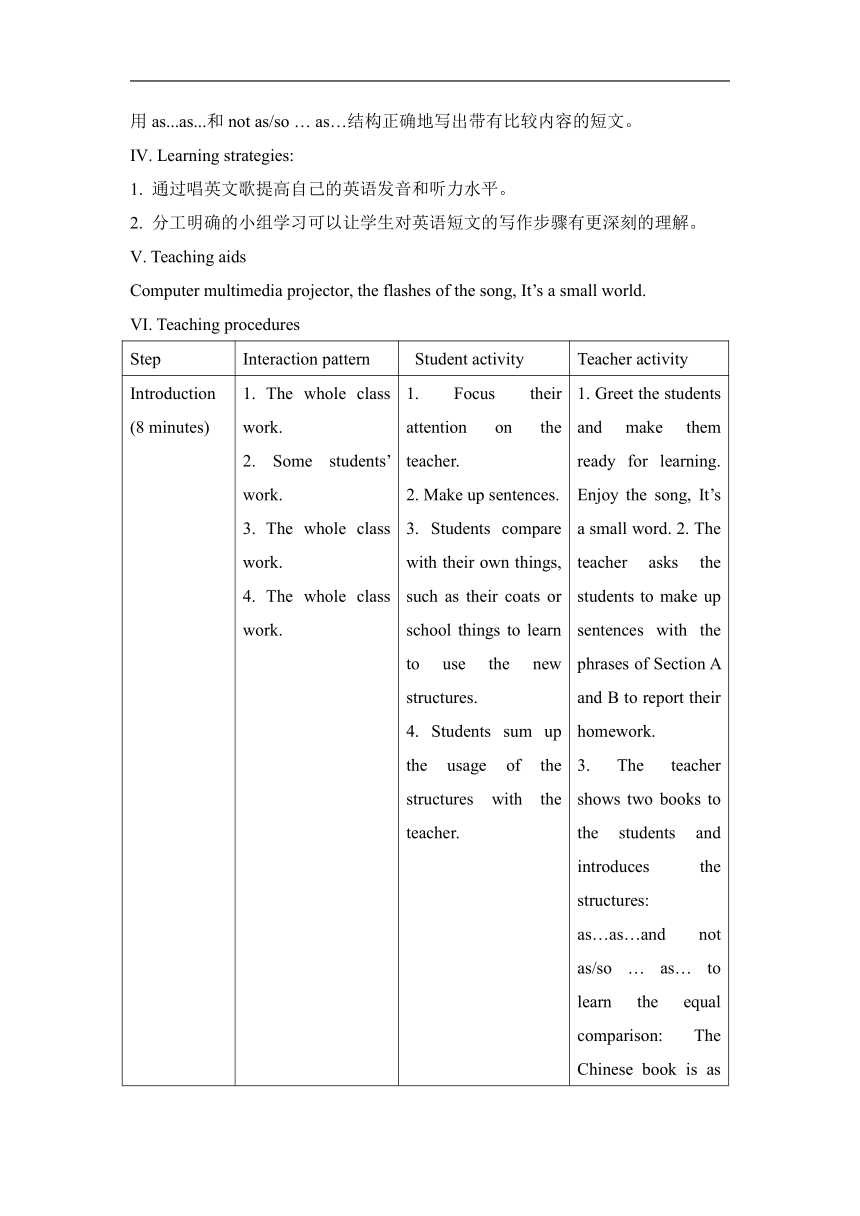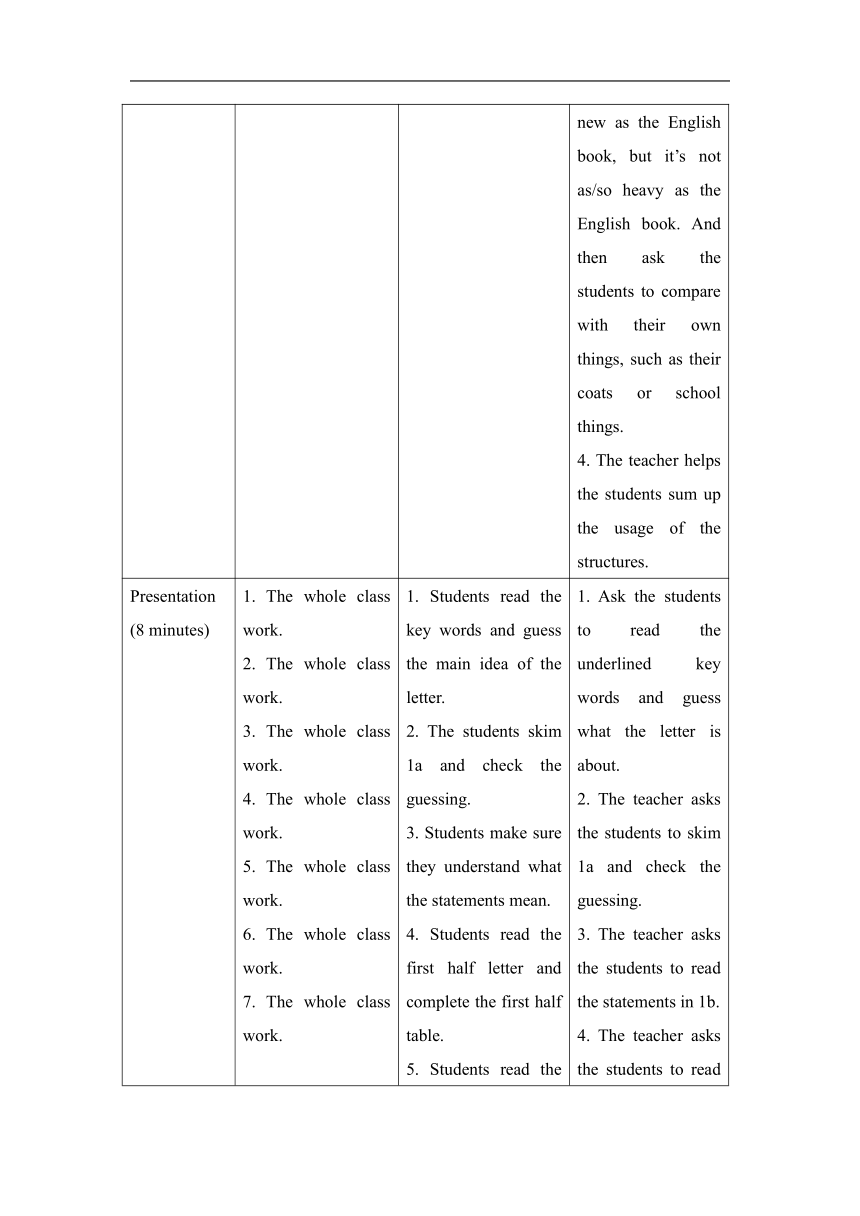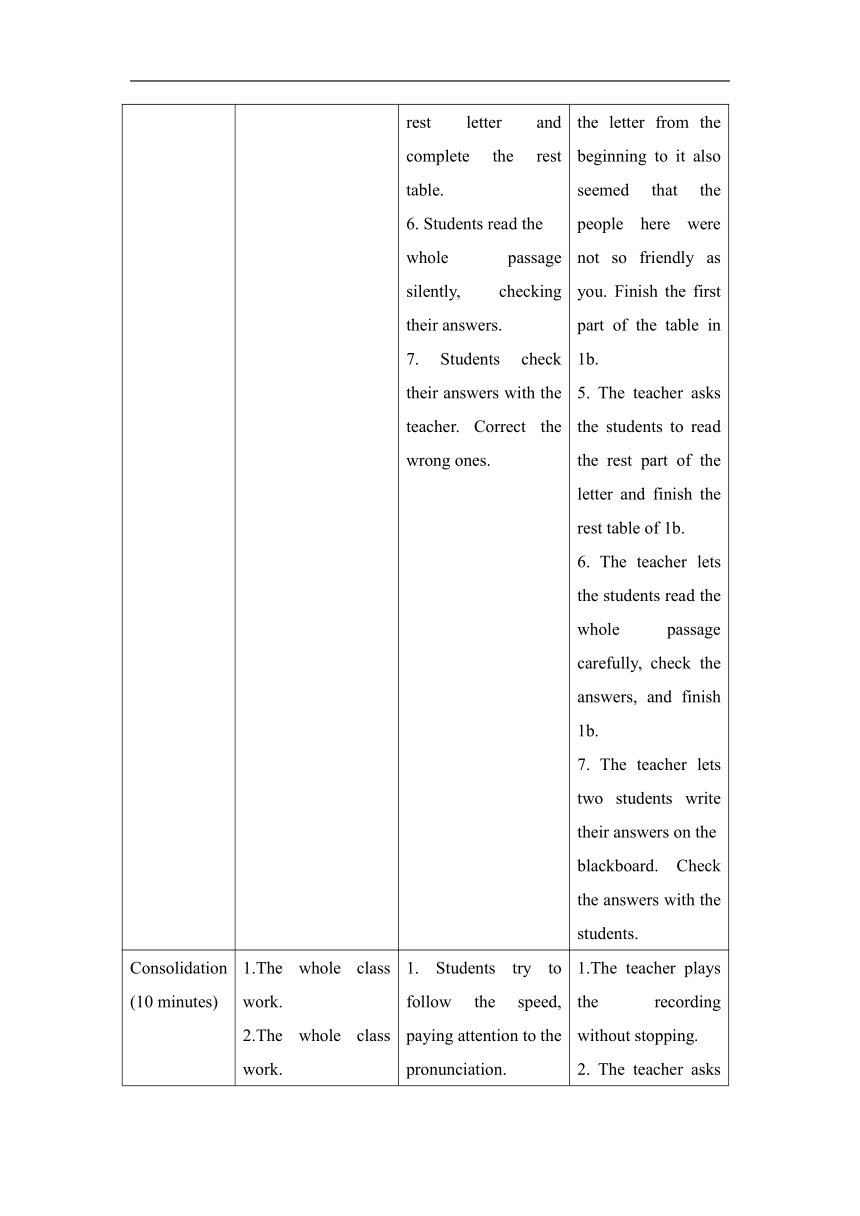Unit 5 Topic2 I’m feeling better now Section C 教案
文档属性
| 名称 | Unit 5 Topic2 I’m feeling better now Section C 教案 |  | |
| 格式 | doc | ||
| 文件大小 | 24.2KB | ||
| 资源类型 | 教案 | ||
| 版本资源 | 仁爱科普版 | ||
| 科目 | 英语 | ||
| 更新时间 | 2021-06-01 13:41:28 | ||
图片预览




文档简介
Unit5 Topic2 SectionC优质课教案
Ⅰ. Material analysis:
本节课建议用一课时完成,主要活动为1a和3。
1a的阅读内容为Li Hong 写给以前的同学Xiao Fang的一封信,学生通过信中小红刚刚转学过来时的不习惯和适应了新的学校,老师和同学之后的感受进行的比较,初步理解和掌握形容词和副词原级比较的句式,并在2 和3、4的操练中进一步对该句式进行理 解和运用,同时进一步学习运用描述情绪和情感的形容词。
Ⅱ. Teaching aims Knowledge aims:
1. 学生能根据音标,正确朗读出单词表中单词及短语。
2. 能正确拼读并运用黑体单词。
3. 学生能正确运用as...as...和not as/so … as…结构造句。
4. 学生能正确使用以下词或短语,复述本课课文,简单的介绍课文大意。
a few months ago, upset, lonely, as well as usual, was not used to, not so clean as…, not as delicious as ours, either, not so friendly as you, get used to life here, accept, as happily as before.
Skill aims:
1. 能听懂本课文本材料以及与之内容相关的课堂用语。
2. 能用as…as…和not as/so … as…结构熟练地口头谈论有关两个人或事物同级比较的话题。
3. 能准确朗读课本的文本材料,并能正确地朗读相关的文本材料。
4. 能用as…as…和not as/so … as…结构规范地写出有关自己和朋友的一些情况的比较的短文。
Emotional aims:
教育学生要互爱互助,主动为有困难的同学提供帮助,同时要学会适应新的环境。 Ⅲ. The key points and difficult points key points:
1. 正确运用单词表中单词及短语
2. 正确运用as…as…和not as/so … as…结构进行交谈和写作。
difficult points:
用as...as...和not as/so … as…结构正确地写出带有比较内容的短文。
Ⅳ. Learning strategies:
1. 通过唱英文歌提高自己的英语发音和听力水平。
2. 分工明确的小组学习可以让学生对英语短文的写作步骤有更深刻的理解。
Ⅴ. Teaching aids
Computer multimedia projector, the flashes of the song, It’s a small world.
Ⅵ. Teaching procedures
Step
Interaction pattern
Student activity
Teacher activity
Introduction
(8 minutes)
1. The whole class work.
2. Some students’ work.
3. The whole class work.
4. The whole class work.
1. Focus their attention on the teacher.
2. Make up sentences.
3. Students compare with their own things, such as their coats or school things to learn to use the new structures.
4. Students sum up the usage of the structures with the teacher.
1. Greet the students and make them ready for learning. Enjoy the song, It’s a small word. 2. The teacher asks the students to make up sentences with the phrases of Section A and B to report their homework.
3. The teacher shows two books to the students and introduces the structures: as…as…and not as/so … as… to learn the equal comparison: The Chinese book is as new as the English book, but it’s not as/so heavy as the English book. And then ask the students to compare with their own things, such as their coats or school things.
4. The teacher helps the students sum up the usage of the structures.
Presentation (8 minutes)
1. The whole class work.
2. The whole class work.
3. The whole class work.
4. The whole class work.
5. The whole class work.
6. The whole class work.
7. The whole class work.
1. Students read the key words and guess the main idea of the letter.
2. The students skim 1a and check the guessing.
3. Students make sure they understand what the statements mean.
4. Students read the first half letter and complete the first half table.
5. Students read the rest letter and complete the rest table.
6. Students read the
whole passage silently, checking their answers.
7. Students check their answers with the teacher. Correct the wrong ones.
1. Ask the students to read the underlined key words and guess what the letter is about.
2. The teacher asks the students to skim 1a and check the guessing.
3. The teacher asks the students to read the statements in 1b.
4. The teacher asks the students to read the letter from the beginning to it also seemed that the people here were not so friendly as you. Finish the first part of the table in 1b.
5. The teacher asks the students to read the rest part of the letter and finish the rest table of 1b.
6. The teacher lets the students read the whole passage carefully, check the answers, and finish 1b.
7. The teacher lets two students write their answers on the
blackboard. Check the answers with the students.
Consolidation (10 minutes)
1.The whole class work.
2.The whole class work.
3. The whole class work + group work.
4. The whole class work.
5. The whole class work + group work.
6. The whole class work.
1. Students try to follow the speed, paying attention to the pronunciation.
2. Students read through the passage and find out as…as…and not as/so…as…structures.
3. Students read the passage by themselves and discuss in groups to find out the difficult points and sum up the main points.
4. The students underline in their books and make some notes.
5. Member A should read fluently; Member B should read through the passage by themselves; Member C can read the passage with the help of Member A.
6. Students retell the letter based on the key words and the table in 1b.
1.The teacher plays the recording without stopping.
2. The teacher asks the students to read through the passage and find out as…as…and not as/so … as… structures.
3. The teacher asks the students to find out the difficult points and sum up the main points of the passage.
4. The teacher makes a summary to explain the key points and difficult points to the students.
(1)How time flies! (2)as +形容词/副词原级+ as + 比较对象 not as/so+形容词/副词原级+ as + 比较对象
(3)be/ get used to …
5. The teacher asks the students to read the whole passage in groups, making sure everyone can read through the passage.
6. The teacher asks the students to retell the letter based on the key words and the table in 1b.
Practice
(10 minutes)
1. The whole class work.
2. The whole class work.
3. Individual work.
4. The whole class work.
5. The whole class work.
6. The whole class work.
7. Four students’ work.
8. The whole class work.
1. Students make sure they understand what the statements mean.
2. Students read the words and the sentences of 2.
3. Students complete the sentences with the words in the box.
4. Two students tell the answers. Students check the answers and correct the wrong ones.
5. Students make sure they understand what the statements mean.
6. Students observe the table and the example carefully.
7. Four students write the sentences on the blackboard.
8. Students check the sentences with the teacher and correct the wrong ones.
1. The teacher asks the students to read the statements of 2.
2. The teacher lets the students read the words and the sentences of 2.
3. The teacher asks the students to finish 2.
4. The teacher asks two students to tell the answers for checking.
5. The teacher asks the students to read the statements of 3.
6. The teacher shows an example to the students: Helen is as lovely as Maria.
7. The teacher asks four students from different groups to make sentences with as…as…and not as/so … as… structures on the blackboard.
8. The teacher asks some students to check the sentences, and then the teacher sums up the usage of the structures.
Production
(9 minutes)
1. The whole class work.
2. Pair work.
3. Pair work.
4. Some students’ work.
5. The whole class work.
6. Individual work.
1. Students talk with their partners about the people around them.
2. Students write down the sentences about comparing in pairs.
3. Students join the sentences into a passage.
4. Students show their productions.
5. Students summarize Section C with the teacher.
6. Students finish their homework after class.
1. The teacher asks the students to talk with their partners about the people around them with as…as…and not as/so … as… structures.
2. The teacher asks the students to compare one of their partners with them and write down the sentences in pairs.
3. The teacher asks the students to join the sentences into a passage.
4. The teacher asks the students to show their productions.
5. The teacher summarizes what the students learned today. Important language points are shown on the computer screen.
6. The teacher assigns homework: (1) Review the summary after class. (2)The teacher asks the students to search the Internet for some information about dealing with sadness to prepare for Section D after class.
(3) The teacher assigns The students to review Sections A-C to prepare for Section D.
Teaching Reflection
Most of the students can grasp the equal comparison structure, and the teacher should design more exercises as their homework.
Ⅰ. Material analysis:
本节课建议用一课时完成,主要活动为1a和3。
1a的阅读内容为Li Hong 写给以前的同学Xiao Fang的一封信,学生通过信中小红刚刚转学过来时的不习惯和适应了新的学校,老师和同学之后的感受进行的比较,初步理解和掌握形容词和副词原级比较的句式,并在2 和3、4的操练中进一步对该句式进行理 解和运用,同时进一步学习运用描述情绪和情感的形容词。
Ⅱ. Teaching aims Knowledge aims:
1. 学生能根据音标,正确朗读出单词表中单词及短语。
2. 能正确拼读并运用黑体单词。
3. 学生能正确运用as...as...和not as/so … as…结构造句。
4. 学生能正确使用以下词或短语,复述本课课文,简单的介绍课文大意。
a few months ago, upset, lonely, as well as usual, was not used to, not so clean as…, not as delicious as ours, either, not so friendly as you, get used to life here, accept, as happily as before.
Skill aims:
1. 能听懂本课文本材料以及与之内容相关的课堂用语。
2. 能用as…as…和not as/so … as…结构熟练地口头谈论有关两个人或事物同级比较的话题。
3. 能准确朗读课本的文本材料,并能正确地朗读相关的文本材料。
4. 能用as…as…和not as/so … as…结构规范地写出有关自己和朋友的一些情况的比较的短文。
Emotional aims:
教育学生要互爱互助,主动为有困难的同学提供帮助,同时要学会适应新的环境。 Ⅲ. The key points and difficult points key points:
1. 正确运用单词表中单词及短语
2. 正确运用as…as…和not as/so … as…结构进行交谈和写作。
difficult points:
用as...as...和not as/so … as…结构正确地写出带有比较内容的短文。
Ⅳ. Learning strategies:
1. 通过唱英文歌提高自己的英语发音和听力水平。
2. 分工明确的小组学习可以让学生对英语短文的写作步骤有更深刻的理解。
Ⅴ. Teaching aids
Computer multimedia projector, the flashes of the song, It’s a small world.
Ⅵ. Teaching procedures
Step
Interaction pattern
Student activity
Teacher activity
Introduction
(8 minutes)
1. The whole class work.
2. Some students’ work.
3. The whole class work.
4. The whole class work.
1. Focus their attention on the teacher.
2. Make up sentences.
3. Students compare with their own things, such as their coats or school things to learn to use the new structures.
4. Students sum up the usage of the structures with the teacher.
1. Greet the students and make them ready for learning. Enjoy the song, It’s a small word. 2. The teacher asks the students to make up sentences with the phrases of Section A and B to report their homework.
3. The teacher shows two books to the students and introduces the structures: as…as…and not as/so … as… to learn the equal comparison: The Chinese book is as new as the English book, but it’s not as/so heavy as the English book. And then ask the students to compare with their own things, such as their coats or school things.
4. The teacher helps the students sum up the usage of the structures.
Presentation (8 minutes)
1. The whole class work.
2. The whole class work.
3. The whole class work.
4. The whole class work.
5. The whole class work.
6. The whole class work.
7. The whole class work.
1. Students read the key words and guess the main idea of the letter.
2. The students skim 1a and check the guessing.
3. Students make sure they understand what the statements mean.
4. Students read the first half letter and complete the first half table.
5. Students read the rest letter and complete the rest table.
6. Students read the
whole passage silently, checking their answers.
7. Students check their answers with the teacher. Correct the wrong ones.
1. Ask the students to read the underlined key words and guess what the letter is about.
2. The teacher asks the students to skim 1a and check the guessing.
3. The teacher asks the students to read the statements in 1b.
4. The teacher asks the students to read the letter from the beginning to it also seemed that the people here were not so friendly as you. Finish the first part of the table in 1b.
5. The teacher asks the students to read the rest part of the letter and finish the rest table of 1b.
6. The teacher lets the students read the whole passage carefully, check the answers, and finish 1b.
7. The teacher lets two students write their answers on the
blackboard. Check the answers with the students.
Consolidation (10 minutes)
1.The whole class work.
2.The whole class work.
3. The whole class work + group work.
4. The whole class work.
5. The whole class work + group work.
6. The whole class work.
1. Students try to follow the speed, paying attention to the pronunciation.
2. Students read through the passage and find out as…as…and not as/so…as…structures.
3. Students read the passage by themselves and discuss in groups to find out the difficult points and sum up the main points.
4. The students underline in their books and make some notes.
5. Member A should read fluently; Member B should read through the passage by themselves; Member C can read the passage with the help of Member A.
6. Students retell the letter based on the key words and the table in 1b.
1.The teacher plays the recording without stopping.
2. The teacher asks the students to read through the passage and find out as…as…and not as/so … as… structures.
3. The teacher asks the students to find out the difficult points and sum up the main points of the passage.
4. The teacher makes a summary to explain the key points and difficult points to the students.
(1)How time flies! (2)as +形容词/副词原级+ as + 比较对象 not as/so+形容词/副词原级+ as + 比较对象
(3)be/ get used to …
5. The teacher asks the students to read the whole passage in groups, making sure everyone can read through the passage.
6. The teacher asks the students to retell the letter based on the key words and the table in 1b.
Practice
(10 minutes)
1. The whole class work.
2. The whole class work.
3. Individual work.
4. The whole class work.
5. The whole class work.
6. The whole class work.
7. Four students’ work.
8. The whole class work.
1. Students make sure they understand what the statements mean.
2. Students read the words and the sentences of 2.
3. Students complete the sentences with the words in the box.
4. Two students tell the answers. Students check the answers and correct the wrong ones.
5. Students make sure they understand what the statements mean.
6. Students observe the table and the example carefully.
7. Four students write the sentences on the blackboard.
8. Students check the sentences with the teacher and correct the wrong ones.
1. The teacher asks the students to read the statements of 2.
2. The teacher lets the students read the words and the sentences of 2.
3. The teacher asks the students to finish 2.
4. The teacher asks two students to tell the answers for checking.
5. The teacher asks the students to read the statements of 3.
6. The teacher shows an example to the students: Helen is as lovely as Maria.
7. The teacher asks four students from different groups to make sentences with as…as…and not as/so … as… structures on the blackboard.
8. The teacher asks some students to check the sentences, and then the teacher sums up the usage of the structures.
Production
(9 minutes)
1. The whole class work.
2. Pair work.
3. Pair work.
4. Some students’ work.
5. The whole class work.
6. Individual work.
1. Students talk with their partners about the people around them.
2. Students write down the sentences about comparing in pairs.
3. Students join the sentences into a passage.
4. Students show their productions.
5. Students summarize Section C with the teacher.
6. Students finish their homework after class.
1. The teacher asks the students to talk with their partners about the people around them with as…as…and not as/so … as… structures.
2. The teacher asks the students to compare one of their partners with them and write down the sentences in pairs.
3. The teacher asks the students to join the sentences into a passage.
4. The teacher asks the students to show their productions.
5. The teacher summarizes what the students learned today. Important language points are shown on the computer screen.
6. The teacher assigns homework: (1) Review the summary after class. (2)The teacher asks the students to search the Internet for some information about dealing with sadness to prepare for Section D after class.
(3) The teacher assigns The students to review Sections A-C to prepare for Section D.
Teaching Reflection
Most of the students can grasp the equal comparison structure, and the teacher should design more exercises as their homework.
同课章节目录
- Unit 5 Feeling excited
- Topic 1 You look excited
- Topic 2 I’m feeling better now.
- Topic 3 Many things can affect our feelings.
- Unit 6 Enjoying Cycling
- Topic 1 We're going on a three-day visit to Mount
- Topic 2 How about exploring Tian’anmen Square?
- Topic 3 Bicycle riding is good exercise.
- Unit 7 Food festival
- Topic 1 We’re preparing for a food festival.
- Topic 2 I’m not sure whether I can cook it well.
- Topic 3 I Cooked the Most Successfully
- Unit 8 Our Clothes
- Topic 1 We will have a class fashion show.
- Topic 2 We can design our own uniforms.
- Topic 3 He said the fashion show was wonderful.
